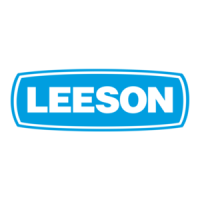TB-1 will be disabled because Parameter 30 - CONTROL will default to LOCAL.
TB-13A, 13B, and 13C will be disabled because Parameters 47, 48, and 49 will default to NONE. If
TB-13C was set to RUN REVERSE, TB-12A will default to a momentary START contact.
TB-13D will default to a normally open EXTERNAL FAULT contact because Parameter 50 - TB13D EXT
will be reset to FAULT.
NOTE: This parameter will display RESET 60, RESET 50 or RST HIGH until a change is made to one or
more of the parameter settings. Once a parameter is changed, the display will change to MAINTAIN.
66 HISTORY (CLEAR FAULT HISTORY)
This parameter is used to clear the previous faults in the FAULT HISTORY. When set to CLEAR and the
ENTER key is pushed, the display will change to MAINTAIN, and the FAULT HISTORY will display NO
FAULT for each of the eight fault histories.
69 LANGUAGE (LANGUAGE SELECTION)
The MICRO Series drive can support other languages with the addition of an optional LANGUAGE
EEPROM chip installed in socket U11 on the control board of the drive. IF the EEPROM is not present,
the default language will be ENGLISH. Also, this parameter is not affected when the parameters are reset
using Parameter 65 - PROGRAM. Therefore, if a language other than ENGLISH is selected, it will remain
in effect after a RESET.
70 FAULT HISTORY
The FAULT HISTORY stores the previous eight fault conditions that caused the drive to trip. The
information stored here is view-only, it can not be altered. The FAULT HISTORY can be used to determine
if there is a pattern, or trend, to the faults, which may indicate a problem in the system. Refer to Section
19.0 - TROUBLESHOOTING for more information on faults.
The FAULT HISTORY indicates the number of the fault (number 1 is the most recent fault), the fault
message, and the status of the drive at the time of the fault. An example is shown below:
In the example above, the third fault log is being viewed, which is an OVERLOAD fault that occurred while
the drive was in a RUN state.
68

